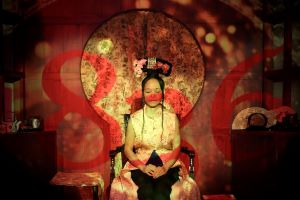Despite some opening night jitters, a production of Léo Delibes’ Lakmé, produced by UNCG Theatre and the School of Music and given in Aycock Auditorium on March 31 hit all the crucial points and rang this critic’s “chimes.” Producer and stage director David Holley made a virtue of necessity, creating a fine unit set that, with slight additions and subtle lighting, provided a variety of levels for action and in turn functioned believably as a secret shrine in a bamboo forest, a busy market place, and a secluded retreat. A lovely suggestion of a moonlit evening in Act III was one of the memorable achievements of lighting designer Seth Starr. The scene designer was Randall J. McMullen. The opera was sung in French, and the diction of the cast and chorus, expertly prepared by Richard Cox, was outstanding, although Aycock’s acoustical quirkiness tended to cloud the clarity of singers when they were in the back half of the stage. Brilliant colors and realistic recreations of period styles were characteristics of the lovely costumes designed by Deborah Bell and Matthew Fuller. The supertitles, prepared by Holley and Louisa Gabriele Muller, were well-timed and very good.
Robert Gutter conducted the UNCG Opera Orchestra, a large ensemble that filled the shallow pit. He often secured lovely and idiomatic playing, and some pianissimo sustained tremolos by the strings were gorgeous. The balances were generally good, but if Aycock Auditorium’s pit were deeper and extended under the stage, the brass would surely be less prominent. The cellos were plagued by intonation discrepancies but settled down and were together for crucial support in Gerald’s aria, “Prendre le dessin d’un bijou.” Principal violist Eric Koontz played with a full robust tone that projected well during Lakmé’s “Les fleurs me paraissent plus belles.” Important woodwind solos were well played, and the tintinnabulations that accompanied the famous “Bell Song” were almost too vivid, due to the hall’s acoustics.
Soprano Julie Celona-VanGorden’s warm voice and precise pitch control made for an outstanding Lakmé. Her voice was wonderfully even across its range and at all dynamic levels. When she hit her high notes at maximum volume, they were exactly right – gleaming jewels with no spreading under pressure. Needless to say, her “Jewel Song” was marvelous in every way. Mezzo-soprano Stephanie J. Foley, as Lakmé’s servant Mallika, was a worthy partner in the great duet “Viens Mallika,” with its wonderfully intertwining lines. James A. McClure, portraying Nilakantha, the merciless Brahmin Priest, has a somewhat dry bass-baritone but was fully engaged dramatically, portraying his character’s wrath. While tenor Daniel C. Stein was a bit wooden in his portrayal of Gérald, a British Army Officer who falls in love with Lakmé, his unstrained light tenor voice has a lovely timbre, and he used it with considerable nuance. A fine, solid baritone and full identification with the character of Frederic were among the key qualities Aaron Phillips brought to his role as a British Army officer. His robust voice hints at a fine future Don Giovanni. Mezzo-soprano Sara Dougherty illuminated the full measure of Miss Benson, the English governess who is very much at sea among the “foreigners” in India, a classic feature of English literature aptly limned by Delibes and his librettists. Soprano Rebecca Meyers as Ellen and mezzo-soprano Melissa Brobeck as Rose, the Governor’s entitled – and spoiled – daughters, were excellent. They brought both characters fully to life and had well-supported and supple voices that were heard to advantage in solos and ensembles.
Matthew Lawing’s firm and pleasant tenor voice was an asset in his restrained delineation of Hadji, a servant loyal to Lakmé and sensitive to her inner desires. Two Chapel Hillians – baritone Jesse Darden as the agile Pick Pocket and mezzo-soprano Priscilla Jane Smith as the flamboyant Gypsy Fortune Teller – did well in their minor roles. Their voices are promising. (Smith was also the cover for the role of Mallika.) Soprano Hyun-Jong Lee was the Chinese Merchant.
Choreography by Kathleen Caviness (who has had extensive experience with traditional Indian dance) and Elissa Minet Fuchs involved subtle stylized hand gestures and ritualized body language for six dancers, led by Caviness.
***
Operas are usually so well done at both UNCG and the NCSA that I cannot resist catching repeat performances of those that are rarely performed or performed particularly well. Such was the case with Lakmé, which tempted me back for the performance of April 3. It was clear during the reviewed opening night that many minor musical rough spots would be cleared up and coalesce into a fully satisfying production as musicians onstage and in the pit got used to their parts. Orchestral balances were much improved. The cello section played as one with fine intonation. Other strings bought out even more delicacy in their playing, in the more intimate scenes, than on March 31.
The “Flower Duet” and “Bell Song” were gorgeous. Soprano Rebecca Meyers encapsulated the character of Ellen in a nuanced rendering of her Act II solo, “Oui! Je suis radieuse!” Most improved in the cast was the Gérald of tenor Daniel C. Stein, who had gotten much more inside his character. His body language, facial expressions, confidence, and increased stage presence contributed to a much more believable impersonation. His already fine tenor voice had added warmth and conveyed passion more consistently. He has great potential.
Updated 4/5/05 to include comments on the performance of 4/3/05.











